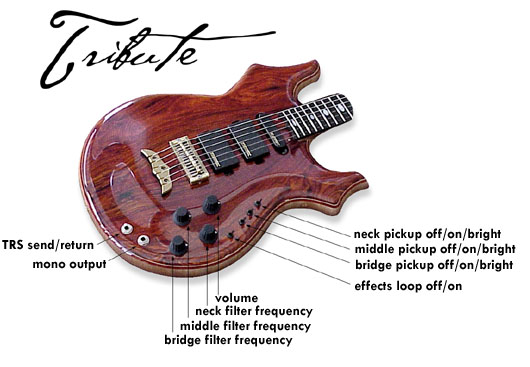
Pickups
The pickups are Alembic STR-HG-HG type, handmade at our factory. Our low impedance pickups deliver
low noise and wide frequency response. The pickups are not intended to voice the sound from the
string, but rather to accurately reproduce the motion of it into the corresponding electrical
signals. Let’s follow these signals through the circuit:
Preamps and individual gain controls
Each pickup has a separate gain control on the inside of the electronics cavity. You can
set the height of each pickup to the level where you prefer the tone the most, then when you are
satisfied with the quality of the sound from each pickup then set the gain to the desired level.
The factory setting aims to set the gains so that each individual pickup is at equal volume when
heard separately.
Filters
Each pickup also has its very own tone control. The filter frequency control determines the cutoff
frequency for each low-pass filter. Only frequencies lower than the one you’ve selected are passed.
We’ve included a modest amount of the natural resonance (Q) found in the classic Alembic circuits to
create a clean and natural sound. By isolating the signal from each pickup, tone changes can
be made to one pickup without affecting the others.
Selector switches and brightness controls
Our design includes an individual selector switch for each pickup - this accesses every possible
combination of the pickups. Each of these switches is three-position, allowing for [off/on/bright]
and a grand total of 27 different pickup settings. In all cases, up is off, center is on and down
is bright. In the photo, all pickups are in the "bright" position.
Summing amplifier and volume
These feed into a summing amplifier and therefore the signals add independently without any
interaction like the summing bus in a recording console. After pickup selection, the signal goes
through the volume control.*
Effects loop
The effects loop is an interesting feature that allows you to insert or delete an outboard effect
(pedal or other similar unit) with a switch conveniently located on the guitar. A TRS stereo
cable transports the signal both to and from the effector through a single cable. The
signal from the volume control feeds the effects send on the tip of jack. The signal returns
on the ring. The effects loop switch selects between the unmodified signal and the effected
signal.
Output
A final unity gain buffer amplifier drives the guitar cable with a robust signal that ensures
the full fidelity will reach the other end of the cable regardless of the length.
The output jack also turns battery on and off. The 9V battery will need to be changed every three or four
months under most circumstances. Always unplug your guitar when you’re not using it.
Jacks are spaced the appropriate distance so traditional large right angle plugs are accommodated.
*Optional setting of the internal patch allows volume control to be at the final output of the instrument. In this mode,
the signal level going to the effector doesn't change when you adjust the volume, especially useful for envelope filters.
|


